
The Bottom Line
Introduction, Specifications, and Pricing
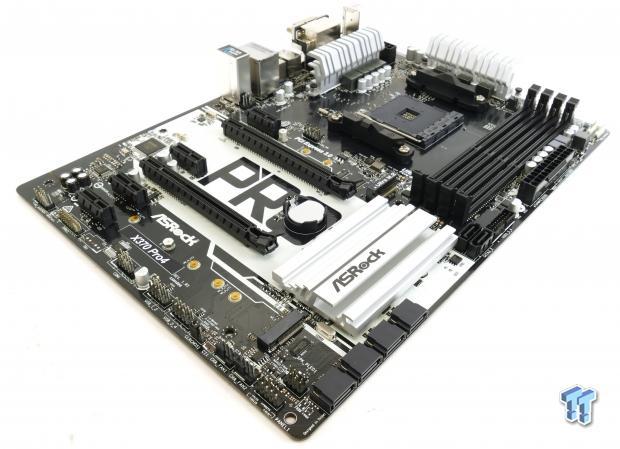
We have taken a look at a few B350 motherboards that support the iGPU capabilities of the new Raven Ridge integrated graphics, but now we will take a look at an X370 motherboard with the same capabilities. The ASRock X370 PRO4 is an X370 motherboard with a very basic feature set, but designed to support the new Ryzen APUs. Let's see what it has to offer.
Specifications

The X370 PRO4 features two M.2 slots, USB 3.0, SATA6Gb/s, and RGB LED support.
Pricing
The X370 PRO4 costs $99.99.
Packaging and X370 PRO4 Overview
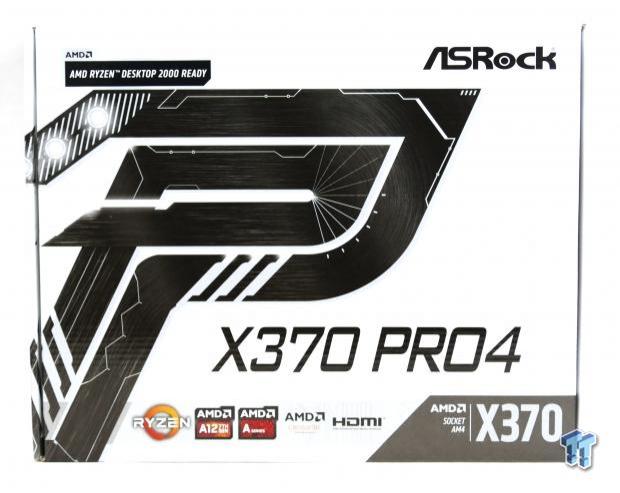
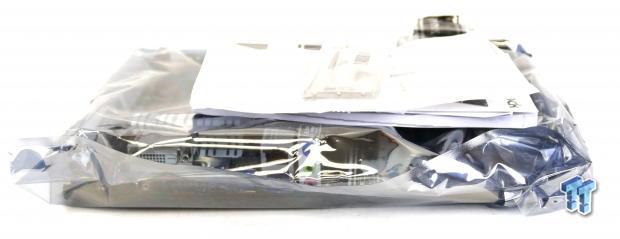
The white and black box uses the same color theme as the motherboard. Packaging is well done and will protect your motherboard just fine.
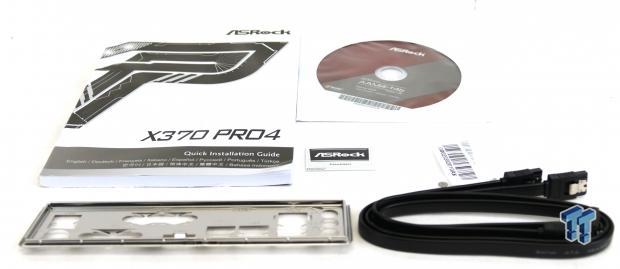
The accessory package includes IO shield, two SATA6Gb/s cables, M.2 screws, case badge, driver DVD, and manual.
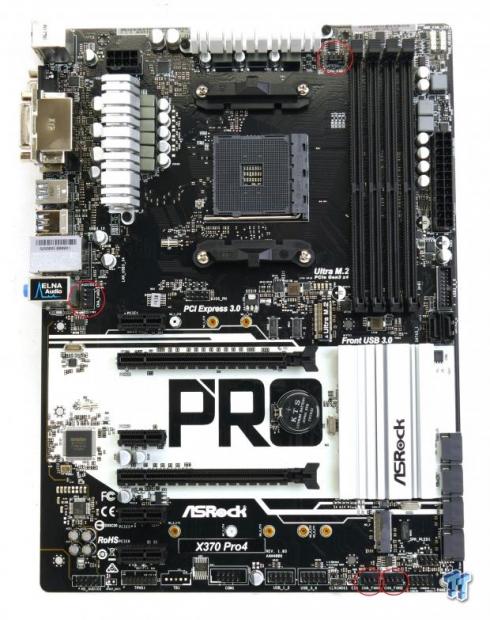
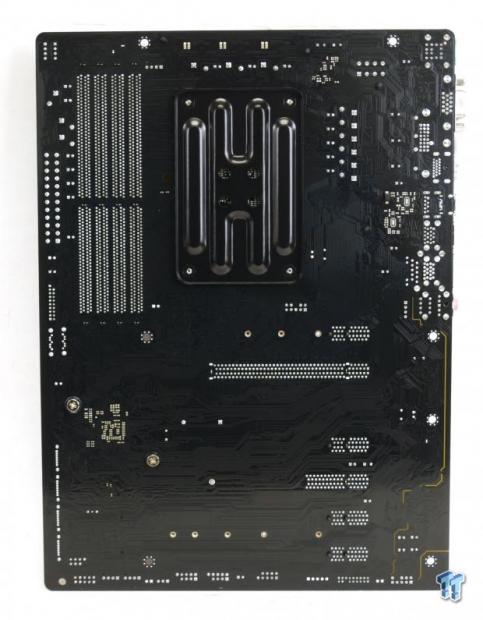
We find four fan headers on the motherboard, all of them are 4-pin PWM/DC mode headers, and we believe they support up to 1A of current. Fan control is done through the UEFI or through ASRock's Windows application. The motherboard features a mostly black PCB and color theme, but with silver heat sinks and a large white portion in the middle. The back of the motherboard is bare of most components.

The rear IO panel features two USB 2.0 ports, PS/2 keyboard/mouse, DVI, VGA (D-SUB), HDMI, five USB 3.0 ports, one USB 3.0 type-C port, 1Gbit LAN, headphone out, line in, and microphone ports.
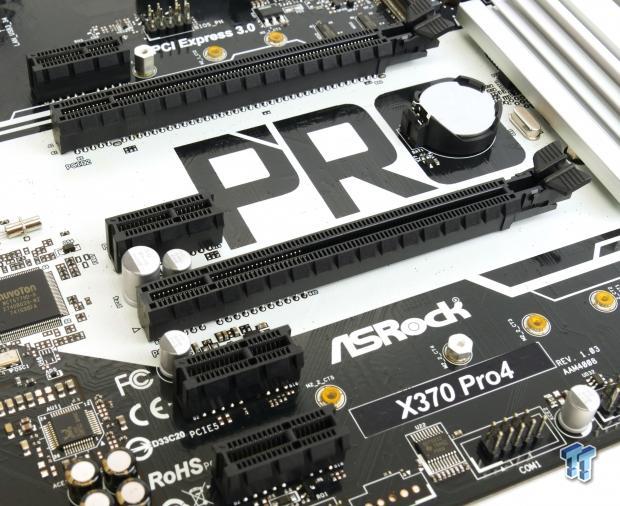
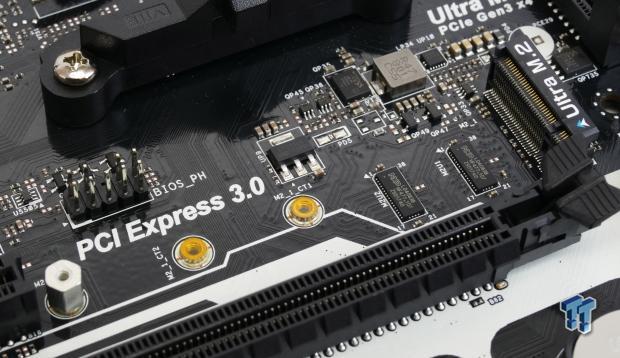
The first x16 slot is wired x16 and the second x16 slot is wired x4. Both of these x16 slots are PCI-E 3.0 slots and do not share bandwidth with each other. The second x4 PCI-E slot gets its bandwidth from the CPU because it shares all its bandwidth with the M.2 M2_1 slot. All four PCI-E x1 slots are x1 PCI-E 2.0 from the PCH.
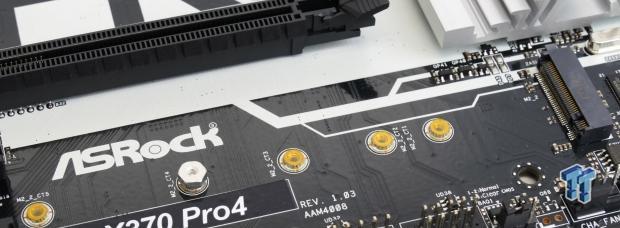
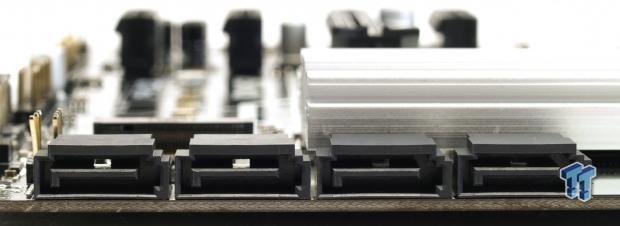
The second M.2 slot is a SATA M.2 slot, so PCI-E based M.2 drives won't work. SATA6Gb/s ports at a 90degree angle are from the FCH (chipset).
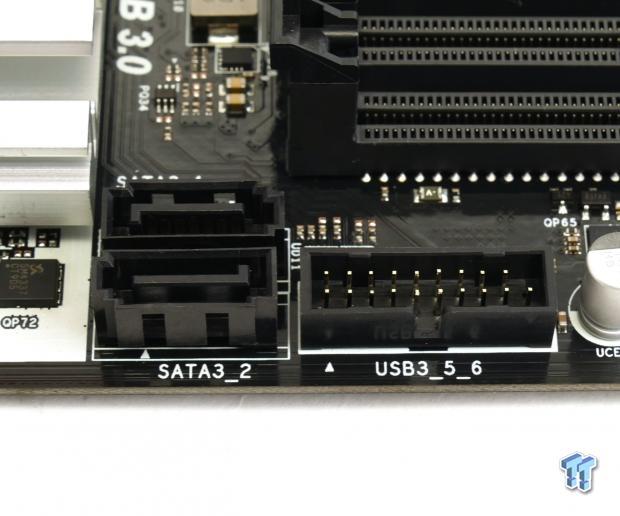
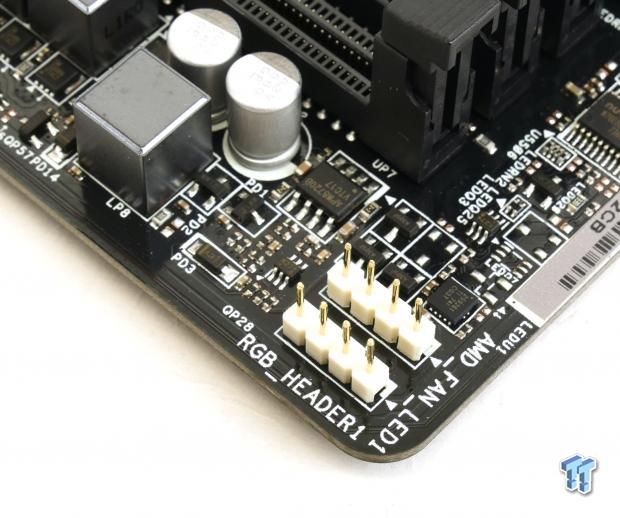
Two more SATA6Gb/s ports get their bandwidth from an ASMedia controller. We also get a USB 3.0 internal header on the motherboard. Two RGB LED headers are located at the top of the motherboard.
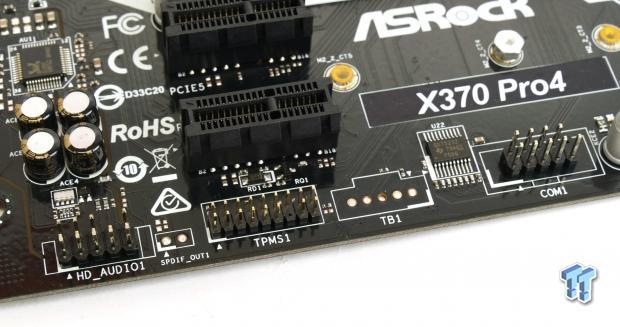
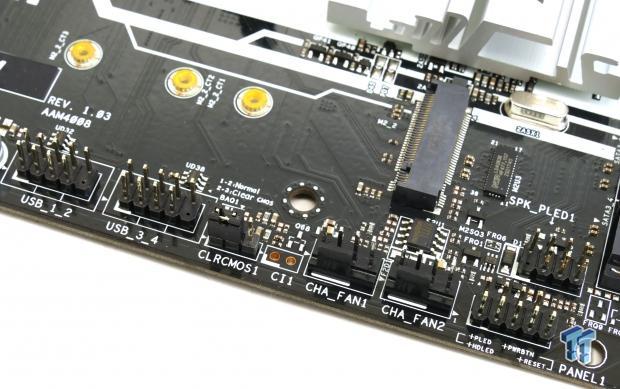
The motherboard also features an HD audio header, TPM header, and COM header. We also fine two USB 2.0 internal headers, a clear CMOS jumper, and front panel headers in the lower right corner of the motherboard.
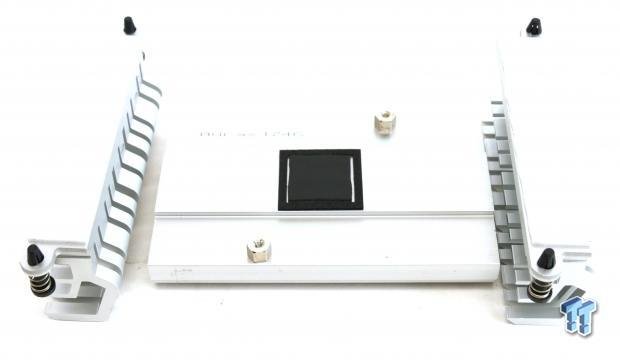
Heatsinks make solid contact with the motherboard and the components they cool.
ASROCK X370 PRO4 Circuit Analysis
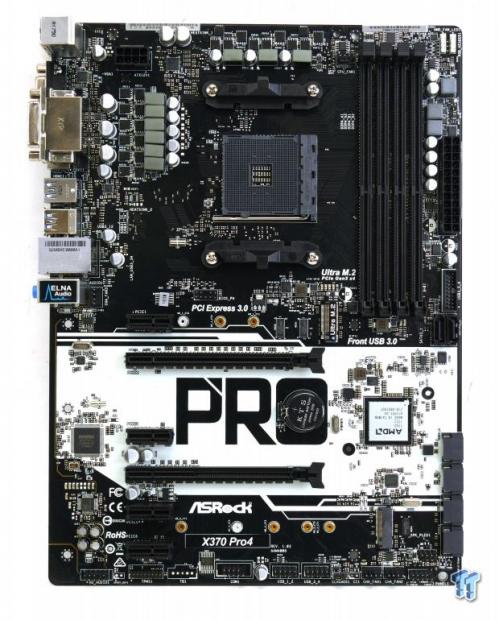
The X370 PRO4 reveals some interesting things when we remove the heat sinks.
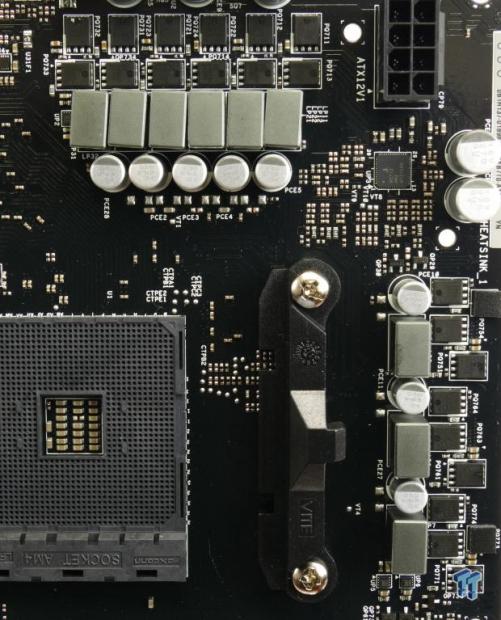
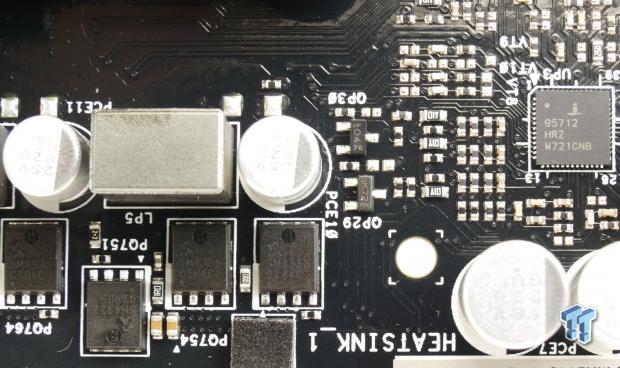
The VRM is in a 6+3 phase configuration, and it uses an Intersil ISL95712 PWM controller which is designed for AMD's platform. The PWM controller has two integrated drivers for the CPU VCore part and one more for the SoC rail.
ASRock adds one more ISL6625A for the VCore and two more for the SoC rail. ASRock doubles the number of power stage components on the CPU VCore rails to get six phases. MOSFETs are the Sinopower SM4336 for the low-side MOSFET and SM4337 for the high-side. The SoC phases get two low-side one high-side configuration while the VCore part gets one low-side and one high-side MOSFET.
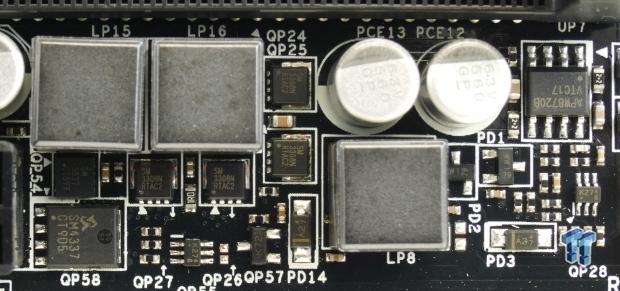
The memory VRM looks like it's using two phases and it's controlled by an Anpec APW8720.
ASROCK X370 PRO4 Circuit Analysis Continued
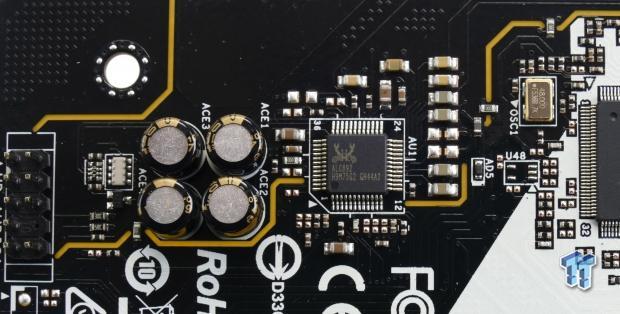
The Realtek ALC892 audio codec is being used with some audio capacitors and physical PCB division to improve audio quality.
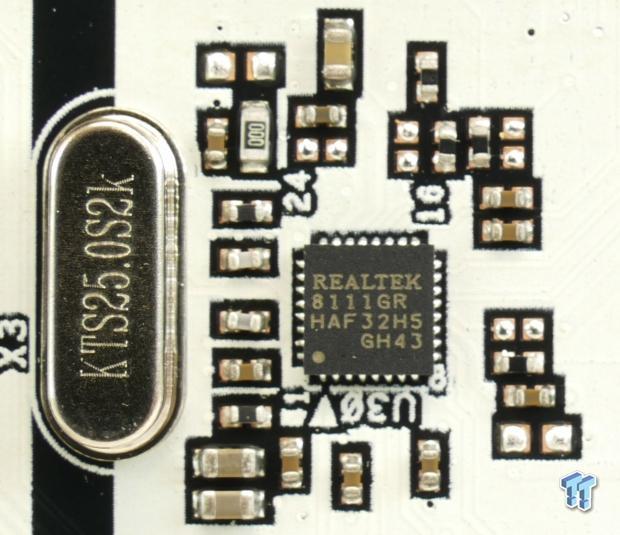
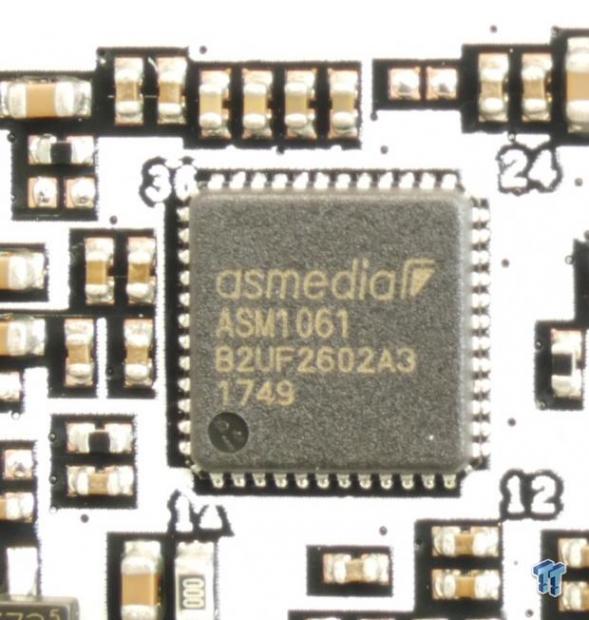
A Realtek RTL8111H 1Gbit NIC is used on the motherboard. An ASMedia ASM1061 is used to expand SATA6Gb/s ports.
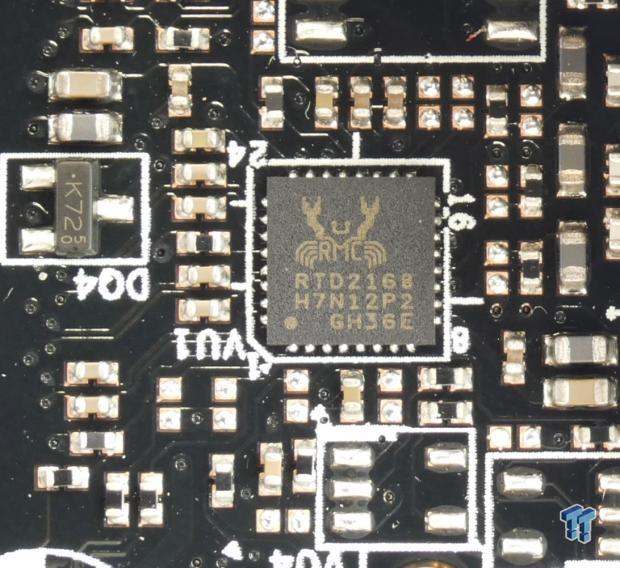
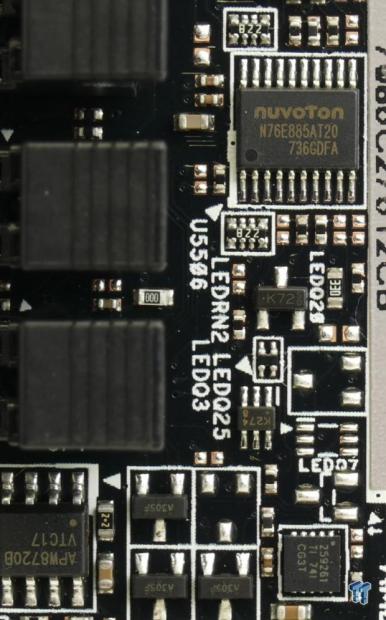
A Realtek RTD2168 is used to provide legacy video outputs from the motherboard. A nuvoton N76E885 is used to provide RGB LED support, and a Texas Instruments eFuse is integrated to provide protection.
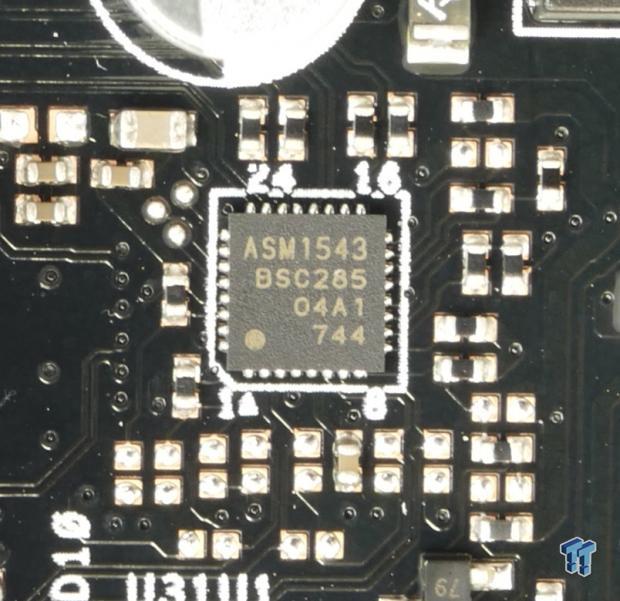
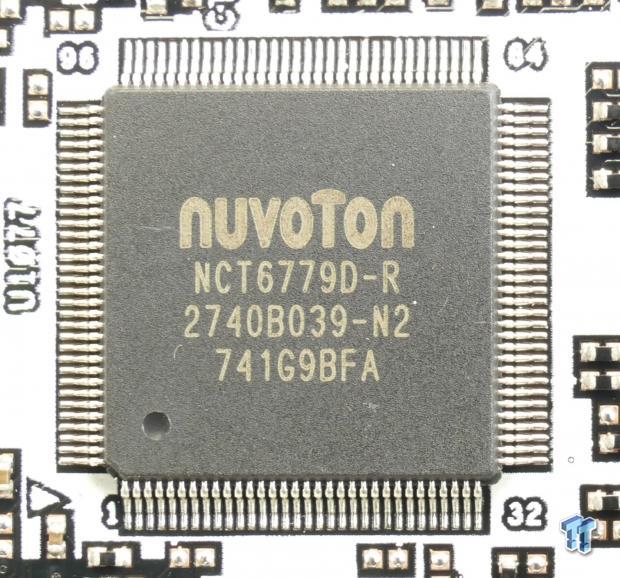
An ASMedia ASM1543 is used to provide the type-C USB port on the rear IO, but because the motherboard doesn't have the proper USB 3.1 redrivers, it can't offer USB 3.1 (10Gb/s). The SuperIO controller is the NCT66779D.
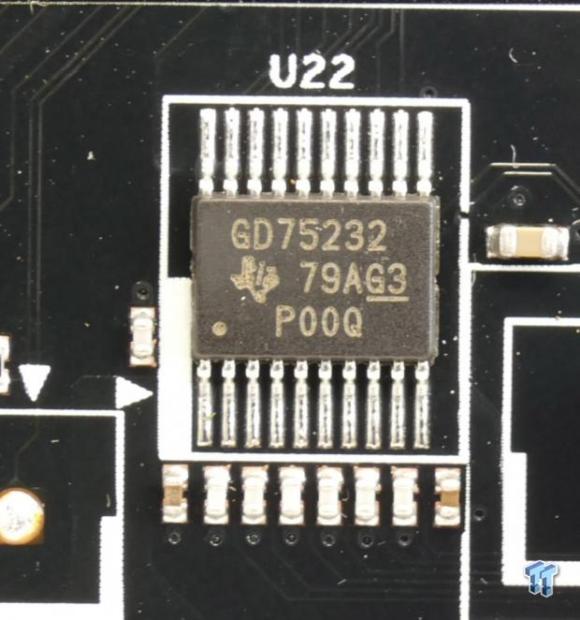

A Texas Instruments GD75232 drivers and receivers chip is used to provide the COM port. A few NXP quick switches each moves x2 PCI-E 3.0 between the M.2_1 slot and the second x16 slot.
BIOS and Software
BIOS
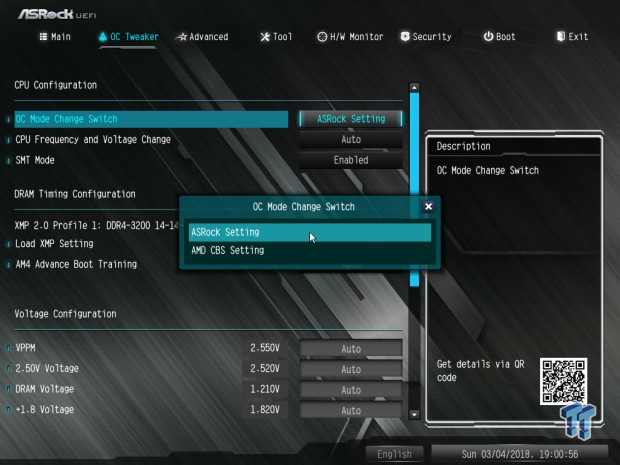
The UEFI is similar to that of many other ASRock motherboards, but it does have some design changes. For instance, there is no GUI for fan control, just manual inputs into a menu, and there is a special setting that allows you to change between AMD CBS overclocking or ASRock's own overclocking settings system. We were able to overclock with ease, and most of your settings are readily available.
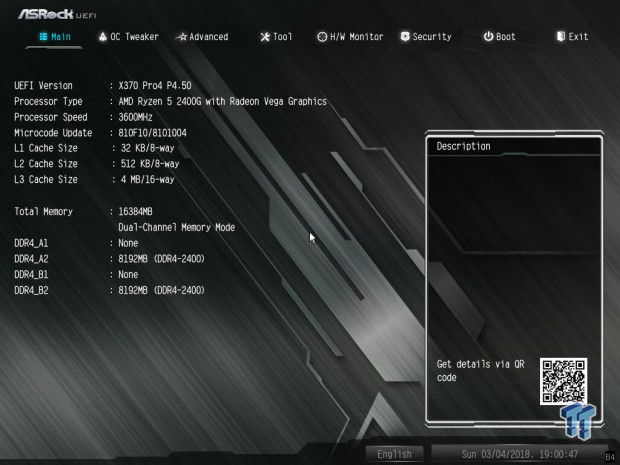
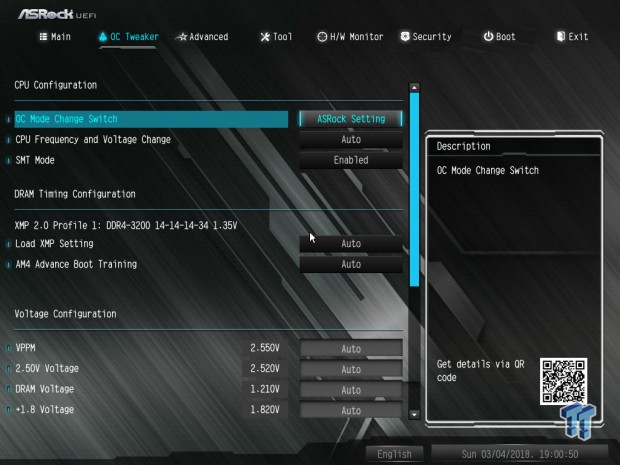
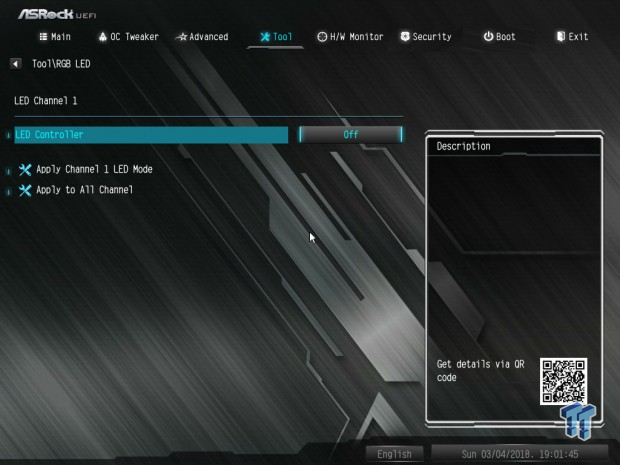
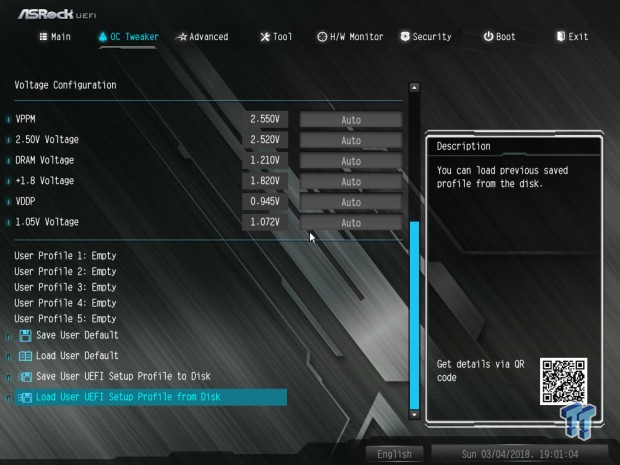

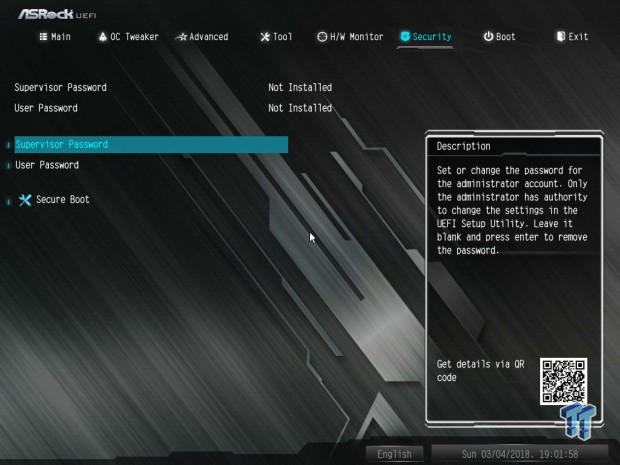

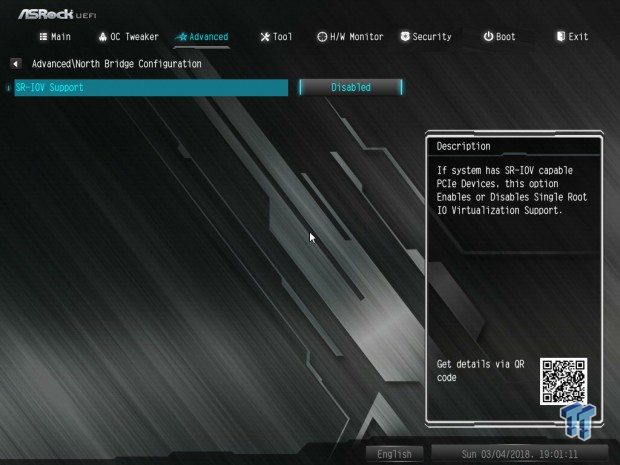
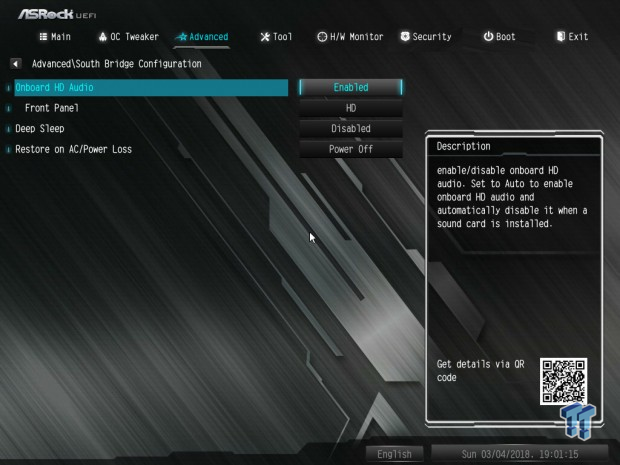
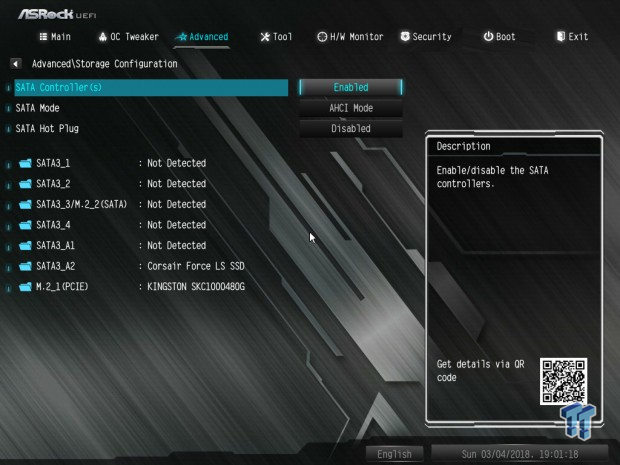
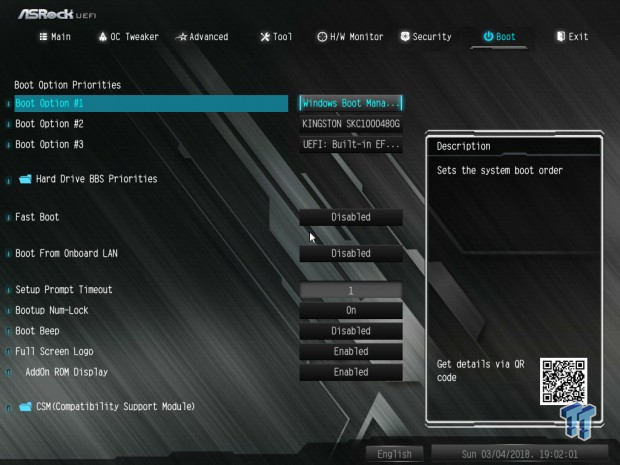
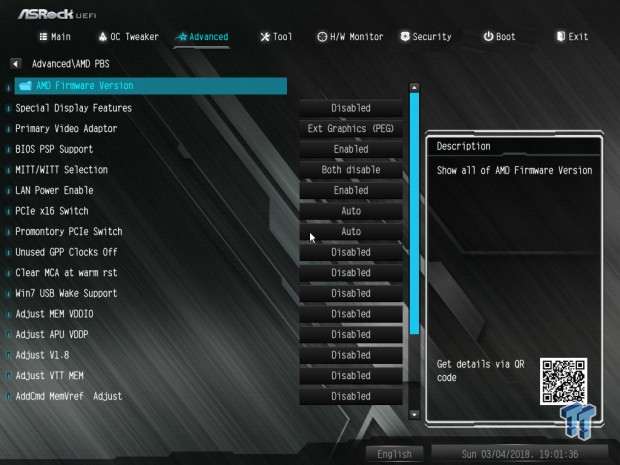
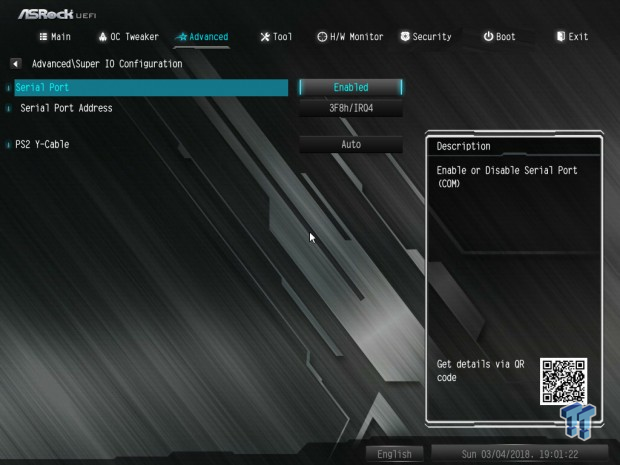
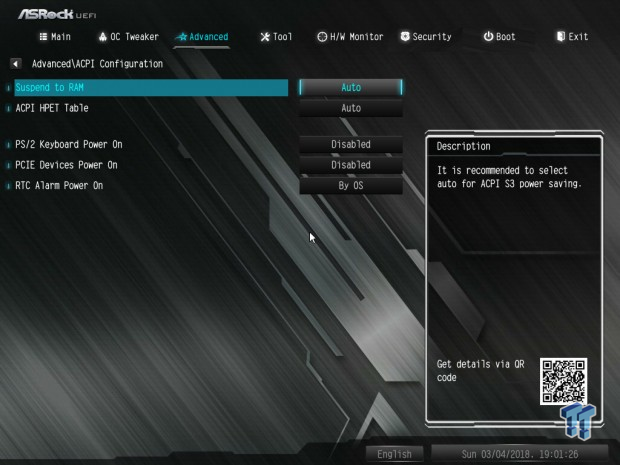
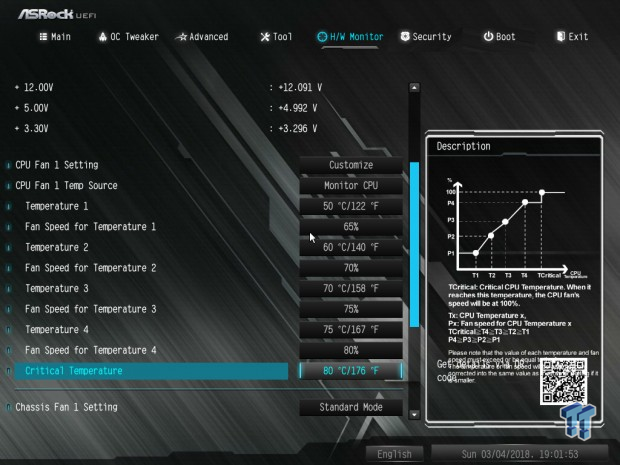
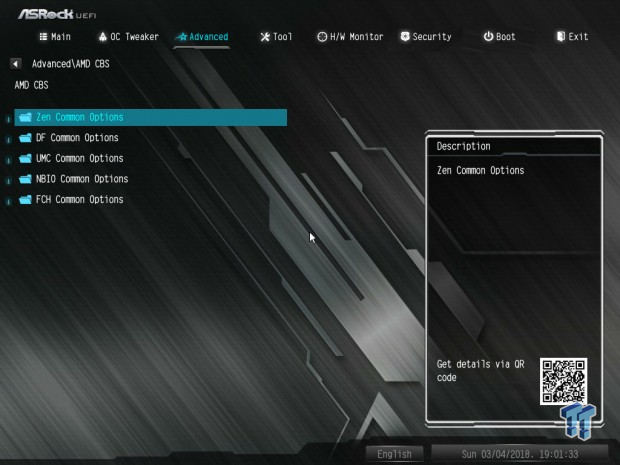
Software
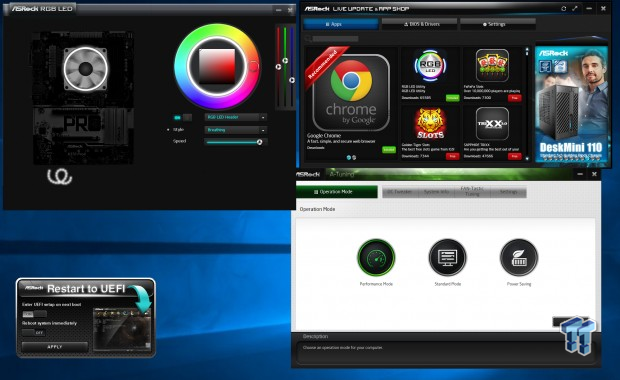
ASROCK's software suite includes APP Shop, A-Tuning, RGB LED, and Restart to UEFI.
Test System Setup
Steven's Motherboard Test System Specifications
- Motherboard: ASROCK X370 Pro4
- CPU: AMD Raven Ridge 2400G
- Cooler: Corsair H110i - Buy from Amazon
- Memory: G.Skill Flare (2x8GB) 3200MHz
- Video Card: Integrated - Buy from Amazon / Read our review
- Storage - Boot Drive: Kingston Predator 240GB
- Storage - SATA6G Drive: Micron Generic 240GB / Read our review
- Storage - USB Drive: Corsair Voyager GS 64GB - Buy from Amazon / Read our review
- Case: Corsair Obsidian 900D - Buy from Amazon / Read our review
- Power Supply: Corsair HX1000 - Buy from Amazon / Read our review
- OS: Microsoft Windows 10 - Buy from Amazon
- Monitor: ASUS PA328 ProArt 32" 4K - Buy from Amazon
- Keyboard: Corsair K70 LUX - Buy from Amazon
- Mouse: Corsair M65 PRO RGB - Buy from Amazon / Read our review
- Headset: Corsair VOID RGB Wireless - Buy from Amazon / Read our review
- Network: ASUS XG-U2008 10Gbit Switch
- BIOS: P4.5
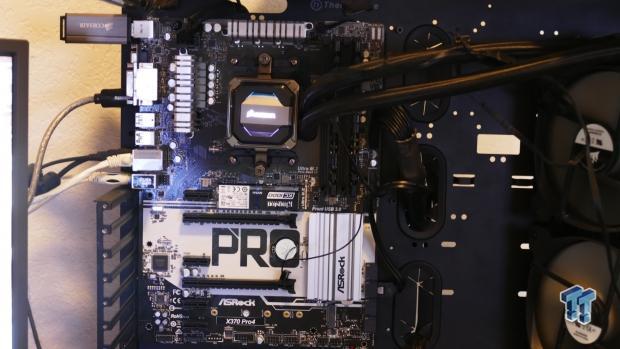
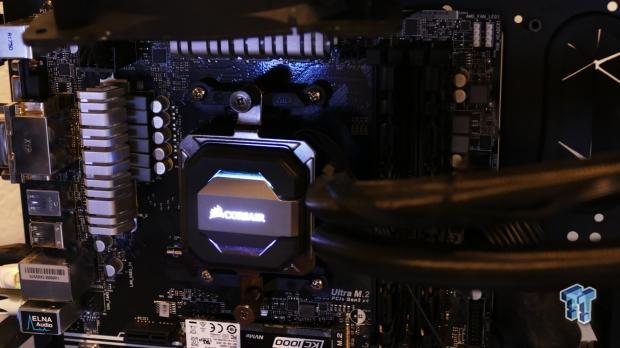
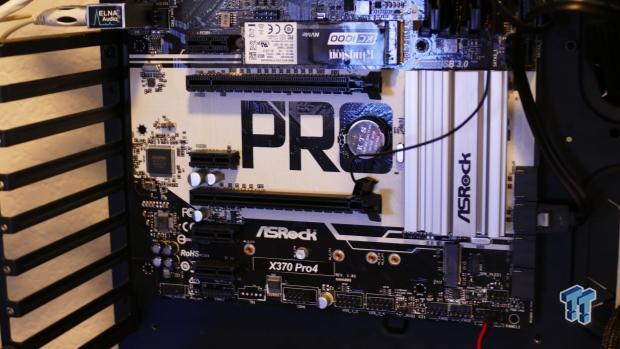
The motherboard has no RGB LEDs, and that means you can just let it fade into the background. If you want a no-nonsense motherboard, this might be the right one for you.
Overclocking
Overclocking Results
CPU Overclocking
Our CPU can overclock to 3.9GHz and do 3200Mhz on memory. I will go through and tell you exactly what I did to achieve my maximum stable overclock, and as AMD's ecosystem of compatible memory kits becomes larger, I will add in a memory compatibility section.
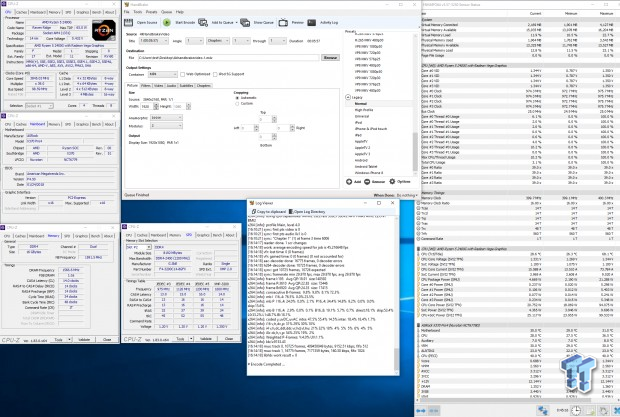
The X370 PRO4 was easy to overclock, I set the CPU to 3900MHz, using ASRock's OC mode, and I set the VCore to 1.35v. I then set XMP to enable, and the system booted the first time without hiccups or further setting changes.
CPU, Memory, and System Benchmarks
CINEBENCH R15
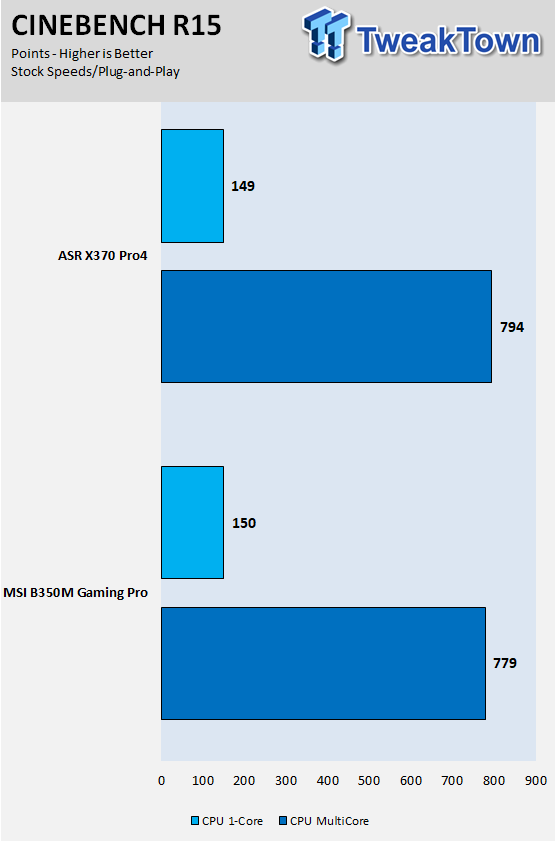
wPrime
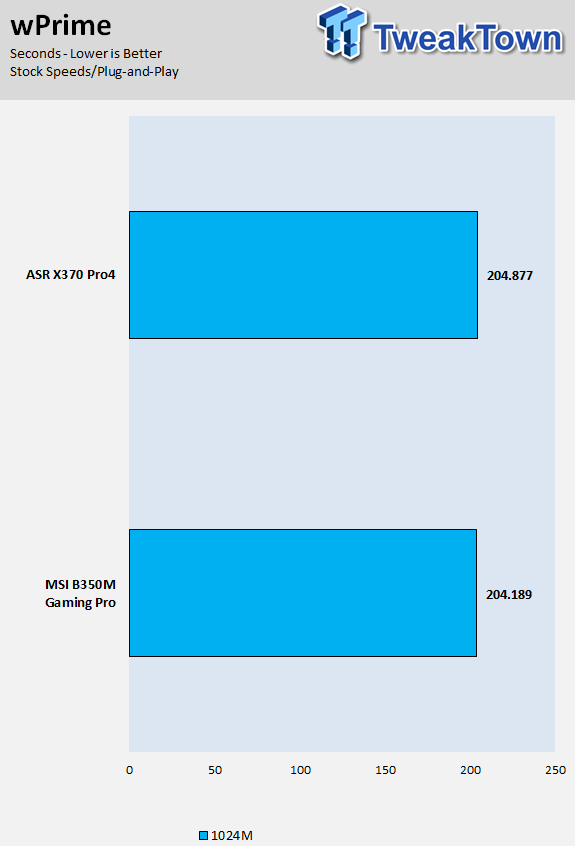
AIDA64 FPU
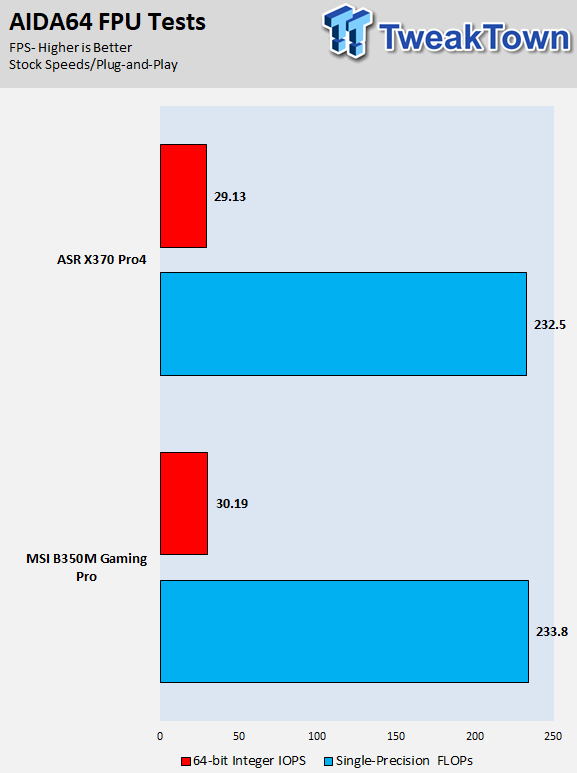
AIDA64 Memory
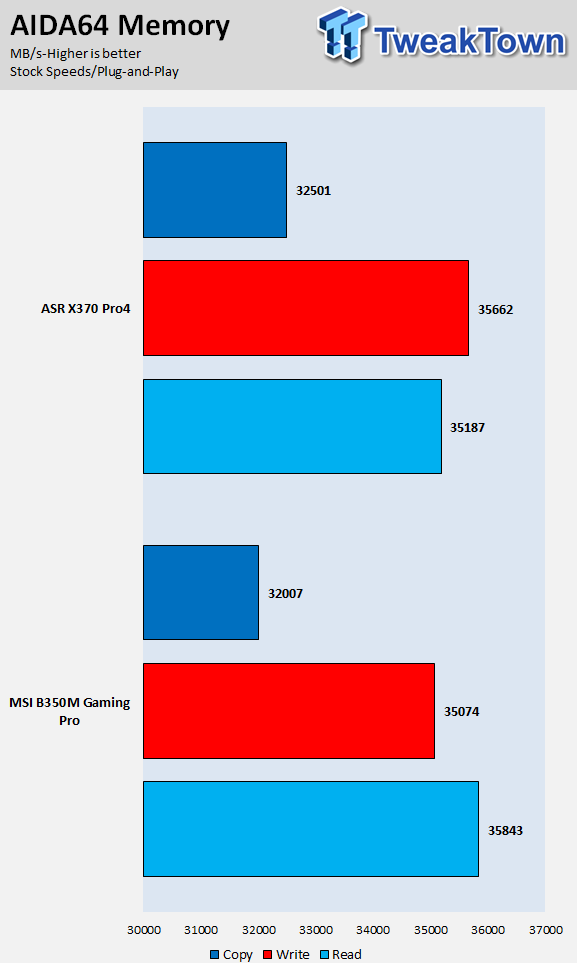
ScienceMark
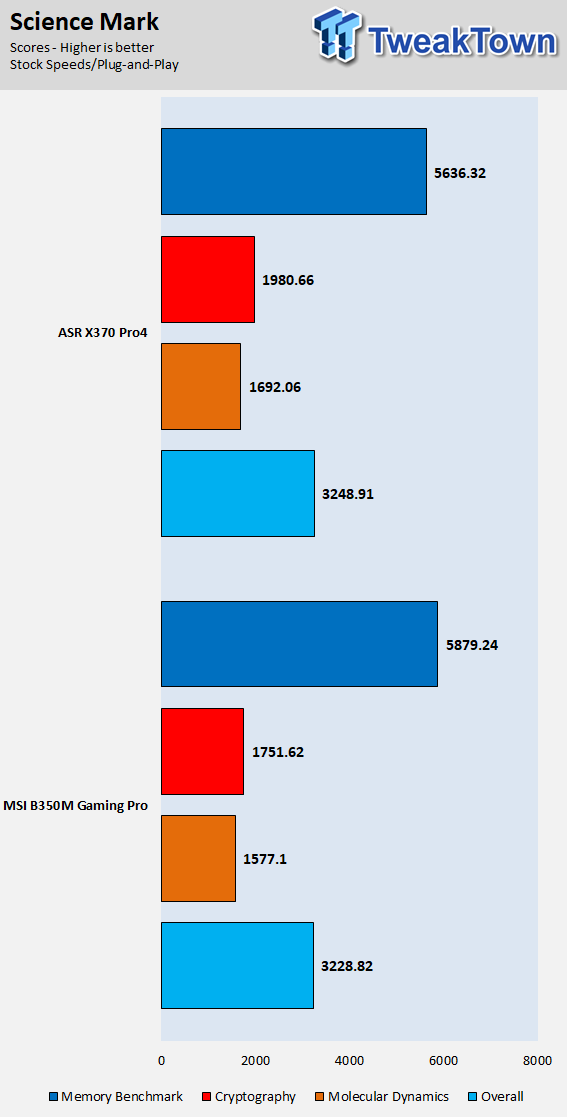
HandBrake
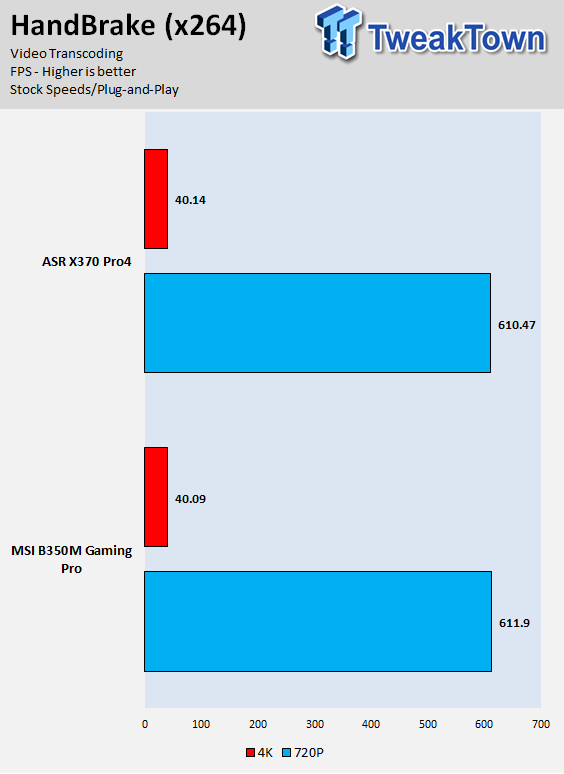
SuperPi 32M
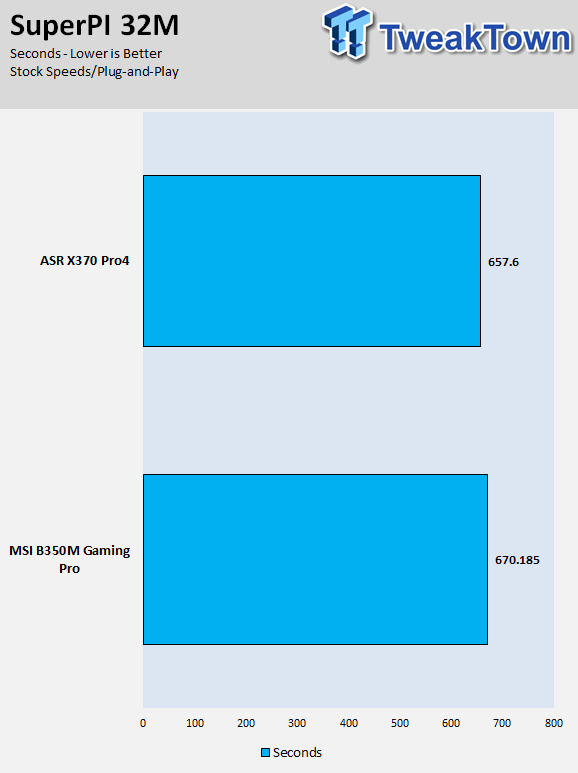
3DMark: Fire Strike
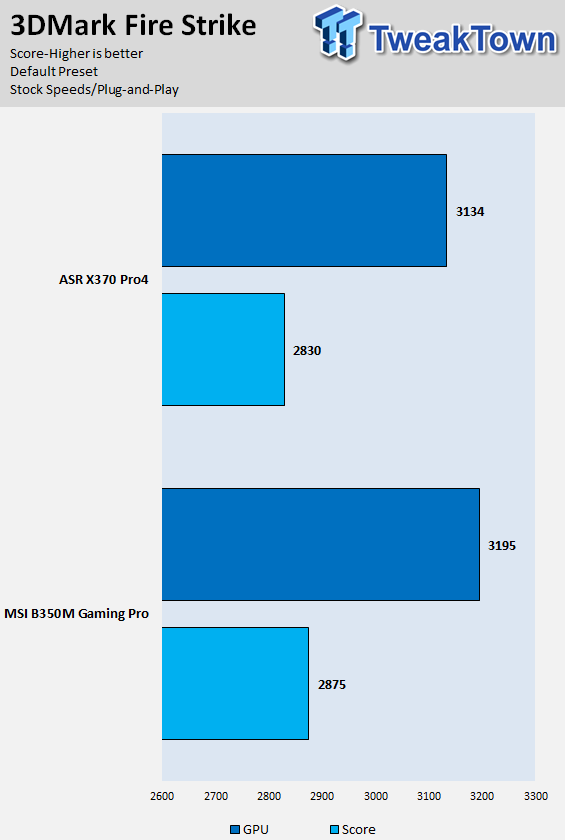
3DMark: Cloud Gate
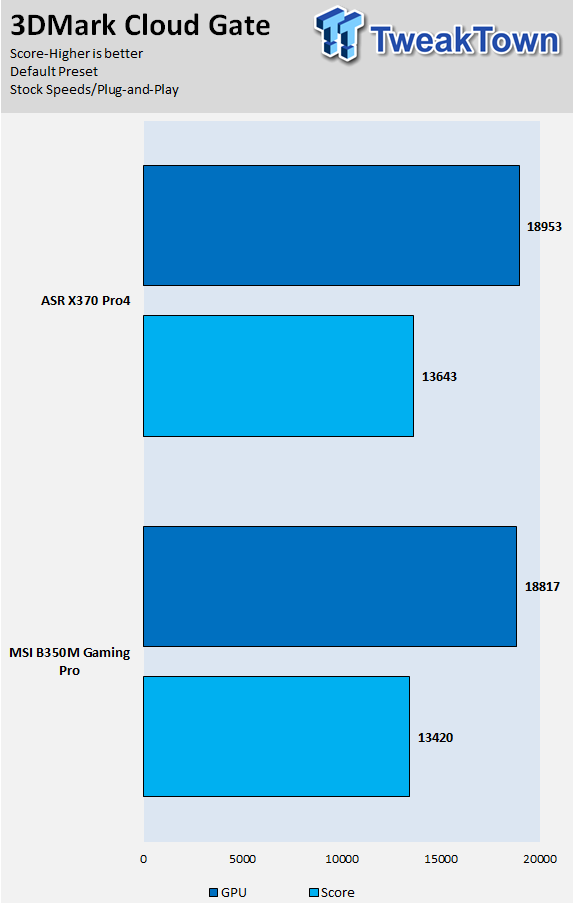
ResidentEvil 6
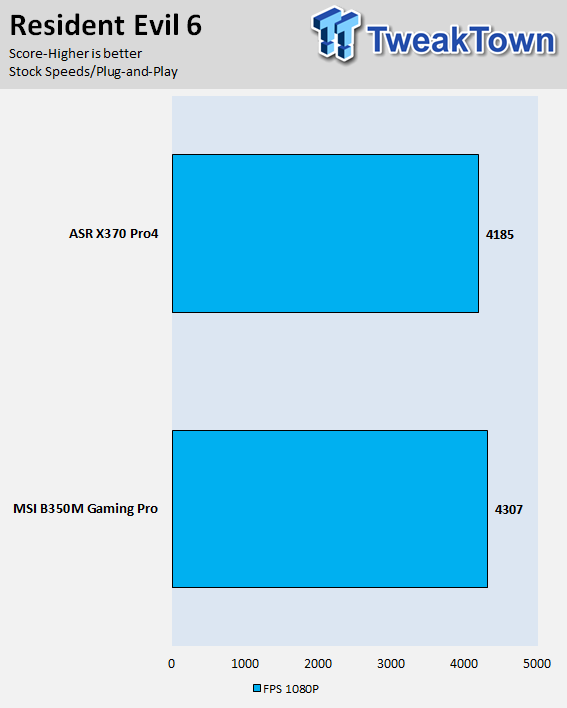
We have only two motherboards in the charts, and that is because we have shifted to use Raven Ridge 2400G instead of the Ryzen 7 1800X when testing these more affordable motherboards. Both UEFIs use the latest AGESA 1.1.0.0, and neither seems to have much of an issue.
System IO Benchmarks
CrystalDiskMark SATA6G:
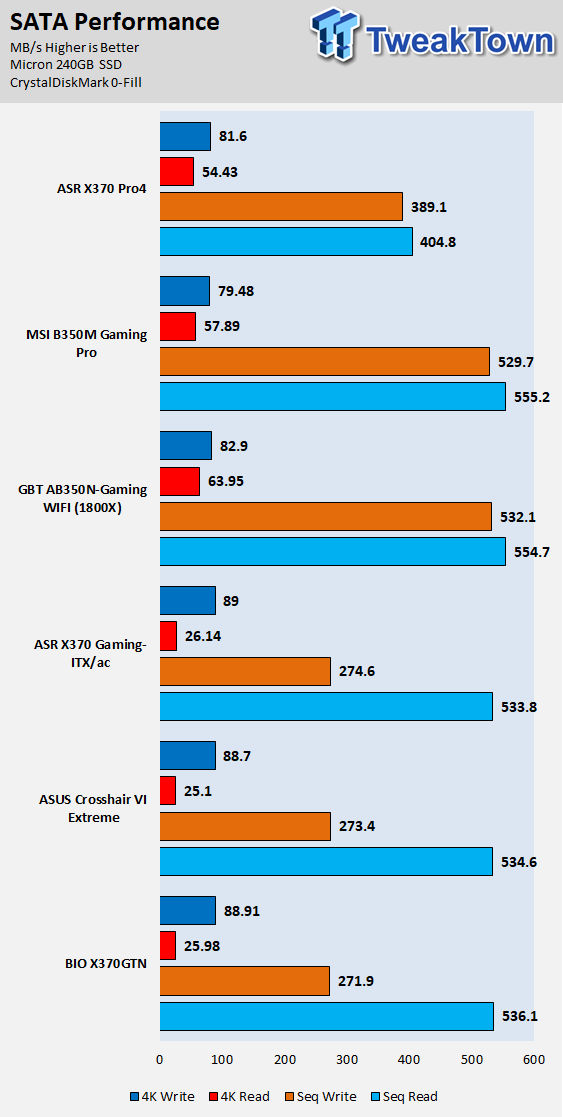
CrystalDiskMark M.2:
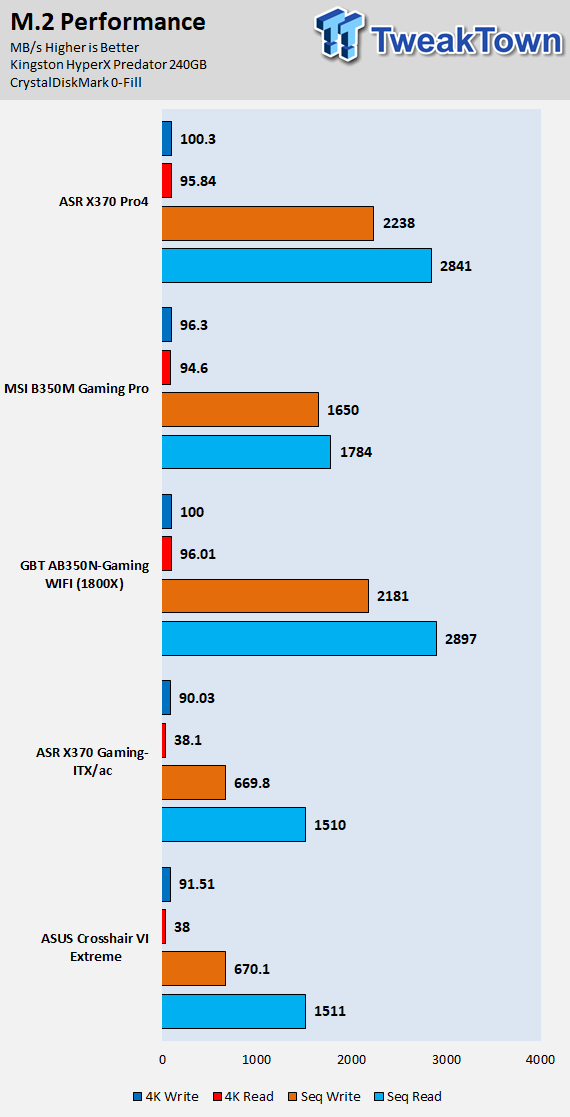
ixChariot Network Throughput:
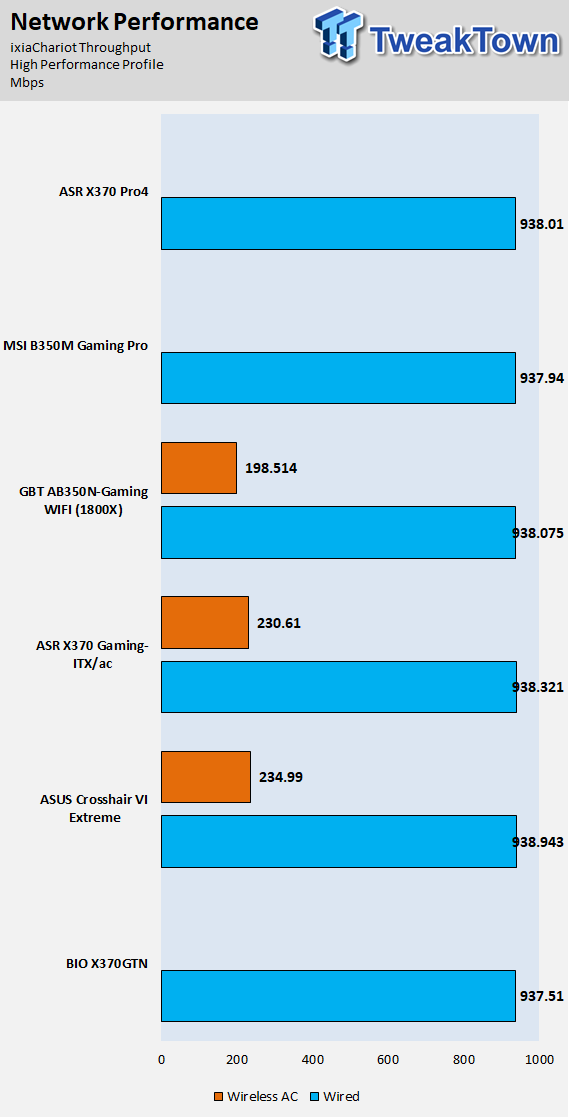
The X370 Pro4 offers great IO performance, except in our SATA results, but that is because we plugged into the ASMedia controller rather than the AMD controller, so your results will be more similar to the other results in our charts if you plug into one of the four AMD ports.
Audio RMAA 5.5:
I disable all audio features, set the correct bitrates, and then test the audio with a loopback test.
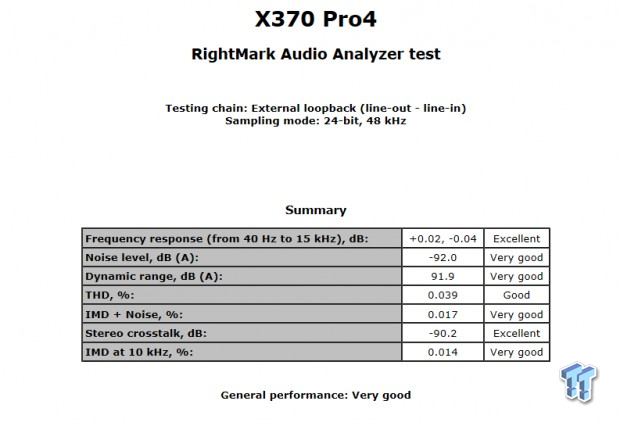
Sound Judgment by Ear: Audio performance was good, overall it was decent for the controller used. There are five ratings for audio: 1. Problems, 2. Okay, 3. Acceptable, 4. Very good, 5. Excellent
Thermal Imaging and Power Consumption
System power is measured at the wall with an AC power meter.
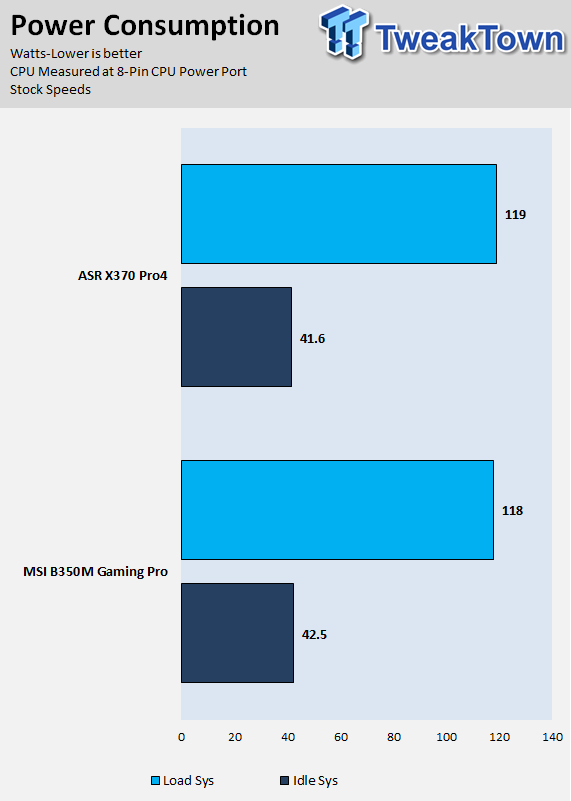
Note on Thermal Images: In the temperature section, we use our Seek thermal imaging camera to capture the surface temperatures of major components on the board. I look at the VRM and then all other things that light up the screen.
If there is something to worry about, then I will state it. Otherwise, I will just show the hotter running parts of the board for fun. Unless some component is over 80-90C, then there isn't anything to worry about.
All systems will act differently, so I will look for commonalities, such as how far from the VRM the heat spreads through the PCB and the difference in temperature between the front side and backside of the PCB.
Keep in mind, the majority of the heat from the VRM goes into the PCB as it is a giant soldered on copper heat sink. A lower temperature on the front of the PCB points towards a more effective heat sink.
Thermal Testing at Stock Speeds:
The image on the left is always at idle, and the image on the right is at load. During ALL TESTS, fans above the VRM that cool the CPU cooler's (Corsair H110i) radiator are turned on to high (12v).
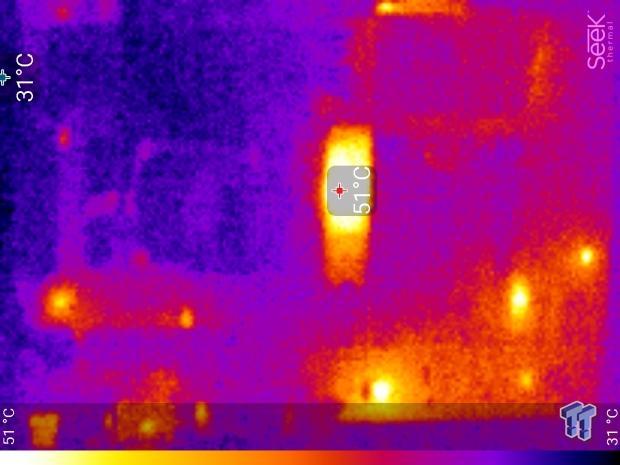
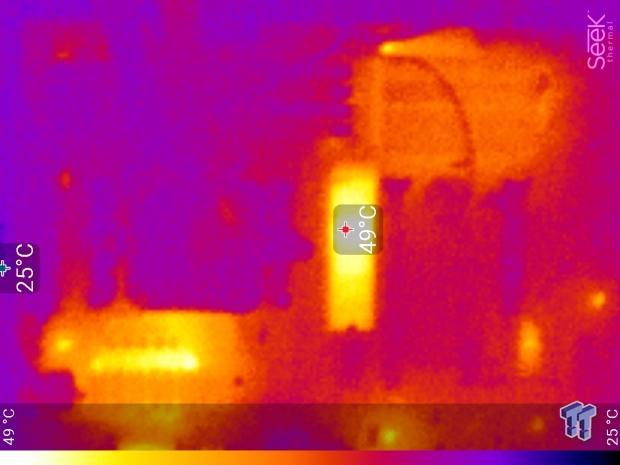
Full frontal.
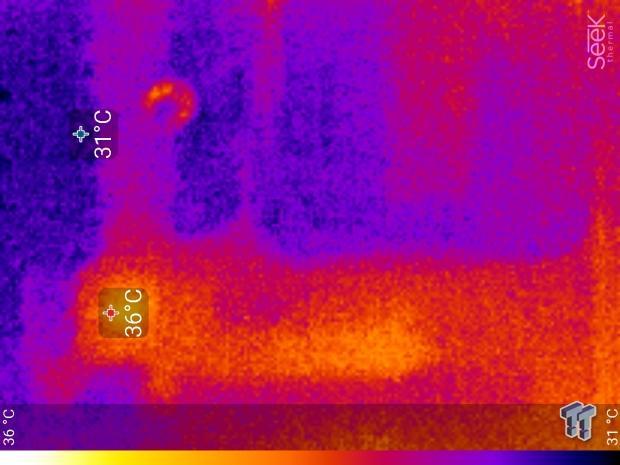
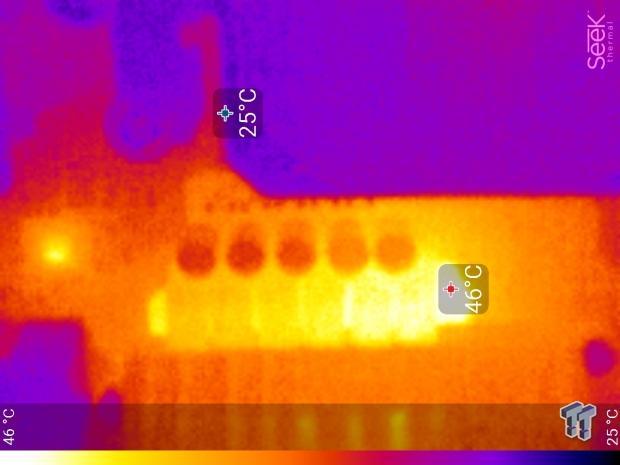
Up-close of the front of the VRM.
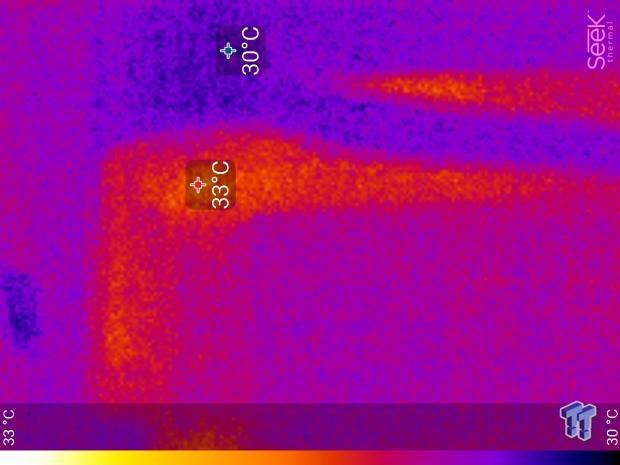
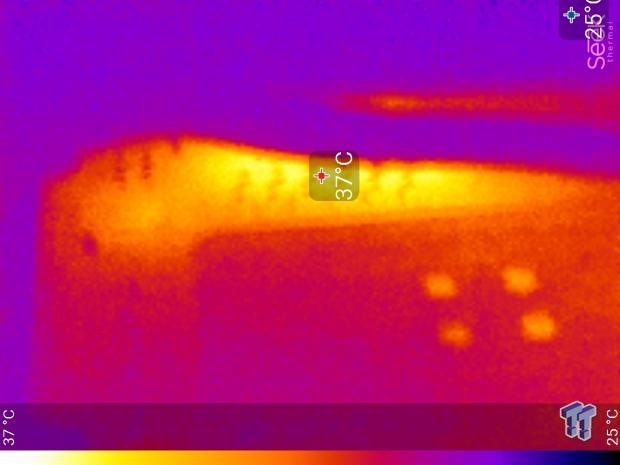
Up-close of the back of the VRM.
The X370 PRO4's VRM is actually very good. I didn't expect it to perform like this, and to be fair; it performed better than overclocked since stock VCore is quite high. Overall, ASRock did a nice job of creating a value VRM capable of overclocking with ease, and all VRM power stages are heatsinked. Anything under 60C is great, 60-80C is acceptable, and anything above 80C is a bit worrisome (if at stock).
What's Hot, What's Not & Final Thoughts
Here are key points about the ASROCK X370 PRO4.
What's Hot
Large VRM: The X370 Pro4 is an X370, which most people feel is meant for AMD's high-end Ryzen 7 processors, and since it needs to support overclocking those processors it means that overclocking AMD's Raven Ridge CPUs is very easy on this motherboard, in regards to the VRM. The SoC phases are also three phases, which is above the average, and should facilitate easy iGPU overclocking.
Dual M.2: One M.2 slot is routed to the CPU x4 PCI-E 3.0, and that slot shares its bandwidth with the x4 electrical slot, so you can technically use AIC storage devices on that slot. The second M.2 slot only supports SATA based M.2 drives, but there are a ton of SATA M.2 drives.
Dual RGB Headers: The motherboard has an RGB header and an AMD FAN LED1 header, but they are pretty much both RGB LED headers, and that is a good thing since the motherboard has no built-in RGB LEDs.
Legacy iGPU Outputs: The rear IO features HDMI, DVI, and VGA (D-Sub) on the rear IO to facilitate many different types of monitors. Many current B350 and X370 motherboards do not offer video outputs on the rear IO, and some of those that do only offer modern connections like HDMI and DisplayPort.
What's Not
No USB 3.1: Although the motherboard has that light blue USB housing on the motherboard, it doesn't offer USB 3.1 (USB 3.1 Gen 2), rather only USB 3.0 (USB 3.1 Gen 1).
Final Thoughts
The ASROCK X370 Pro4 is one of their newer motherboards targeting Raven Ridge buyers. It offers a slightly expanded feature set compared to B350 motherboards, stronger iGPU output support, and a beefier SoC VRM for the iGPU.
It's a solid option for a more enthusiast Raven Ridge build. ASRock's Pro series lineup is basically their gaming series but with less effort put into aesthetics. For starters, this is one of the few motherboards I have reviewed this year without any type of LEDs; the motherboard is totally black.
I should mention that my motherboard came with the ability to boot the new CPUs, although that is not promised (unless it has a sticker that promises 2000 series support). Raven Ridge CPUs require updated UEFIs with AGESA code 1.1.0.0 to work.
Otherwise, you need to flash the BIOS on the motherboard with an older CPU (which AMD will loan you for free). AMD has new UEFIs for all of their AM4 motherboards that fully support the new CPUs. If you are looking for a motherboard for Raven Ridge with features optimized for Raven Ridge, give the X370 Pro4 a look.
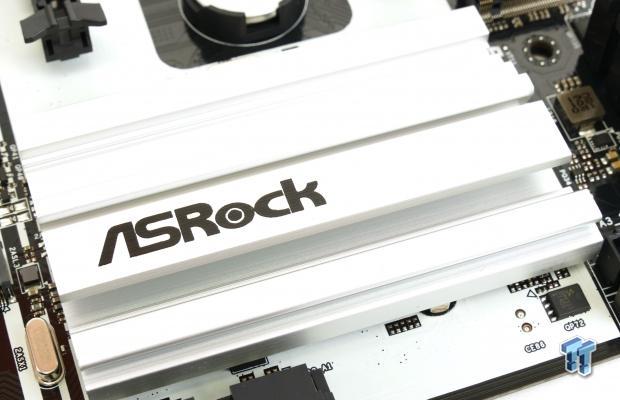

| Performance | 89% |
| Quality | 89% |
| Features | 94% |
| Value | 90% |
| Overall | 91% |
The Bottom Line: The ASRock X370 Pro4 is loaded with features that are designed to fully support any Raven Ridge build.
PRICING: You can find products similar to this one for sale below.
 United
States: Find other tech and computer products like this
over at Amazon.com
United
States: Find other tech and computer products like this
over at Amazon.com
 United
Kingdom: Find other tech and computer products like this
over at Amazon.co.uk
United
Kingdom: Find other tech and computer products like this
over at Amazon.co.uk
 Australia:
Find other tech and computer products like this over at Amazon.com.au
Australia:
Find other tech and computer products like this over at Amazon.com.au
 Canada:
Find other tech and computer products like this over at Amazon.ca
Canada:
Find other tech and computer products like this over at Amazon.ca
 Deutschland:
Finde andere Technik- und Computerprodukte wie dieses auf Amazon.de
Deutschland:
Finde andere Technik- und Computerprodukte wie dieses auf Amazon.de
Related Tags
